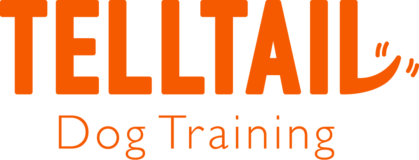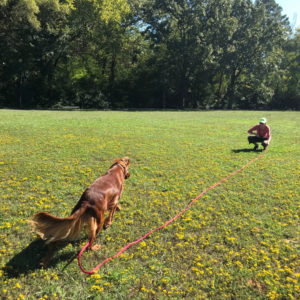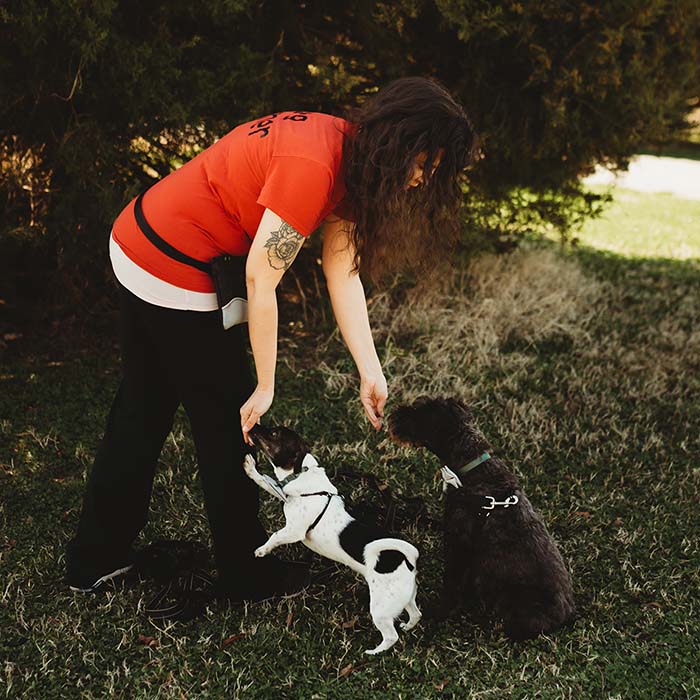From a young age, Cassi Bee wanted a dog.
She’d been horseback riding already for years and she’d started off by asking for a pony. Finally, at age 10, she got a Shibu Inu she named Foxy. They started with group classes. “It was a six-week course, and all of my classmates were much older than me,” Cassi explained. “The instructor approached me after the six-week course and said, ‘I don’t know if you know about this but we have a dog-specific 4-H group.’ That’s how I got started.”
After moving to Philadelphia, she started learning agility through Zoom Room, a franchise with locations across the country. “They had opened up in Philadelphia and my cattle dog was giving me, as folks would say before they learn about some stuff, ‘a really hard time in the city,’” Cassi shared. “I later learned that he was just very, very afraid of everything. He’s from Kentucky. I put him in the middle of Fishtown, Philadelphia, and the world was terrifying. About six months into owning him, I did everything that I knew how to do from my 4-H days, with my very independent, courageous Shiba Inu, and none of those things worked with Bugsy. So I went to the facility. I spoke with the singular trainer there at the time, and she really turned my perspective around on things when she started explaining to me how my training methods were working against my goals, and how it was not encouraging my dog to solve problems. Without problem-solving skills, he wasn’t going to go much farther than we’d gotten.”
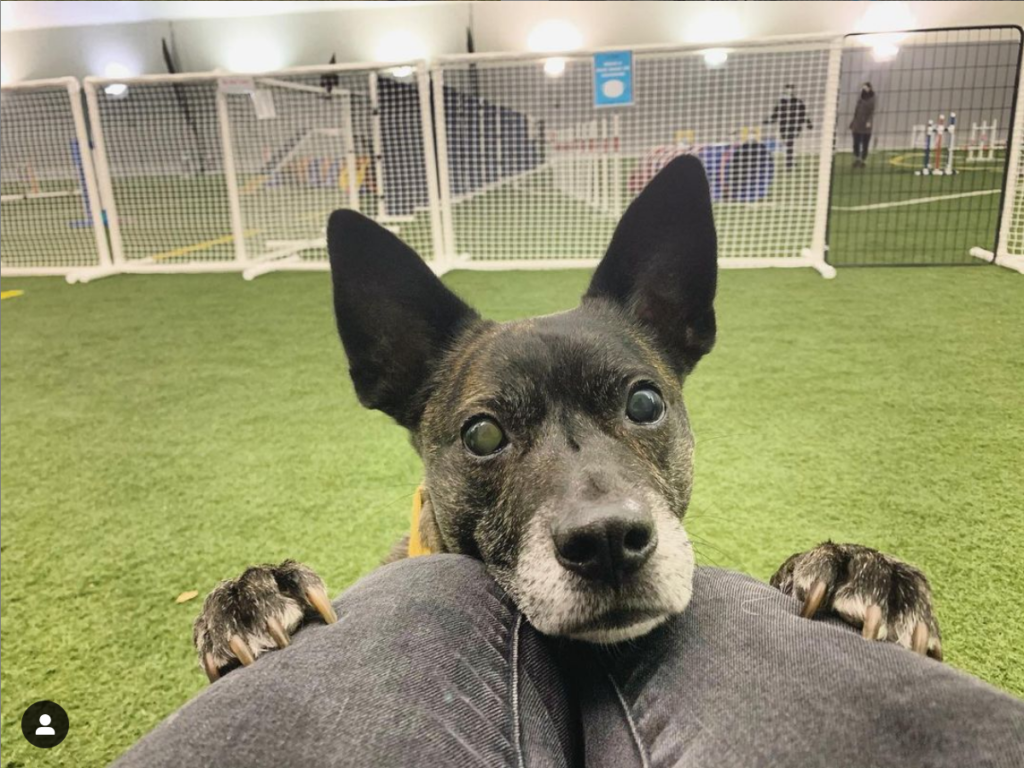
After a challenging first class, she started to see improvements in Bugsy, and the training began to click. She got a job at the Zoom Room and started learning more. Then the Zoom Room closed, and Cassi worked an office job until she heard about Nicole Skeehan’s dog training business, Philly Unleashed, from her veterinarian. “She explained that Nicole had this horse farm in south New Jersey and this lovely arena and all this equipment but really no one to teach classes,” Cassi said. “And she’d just had Dean, and all of that was coming up. Dean was about a year and a half old when I met him. If anyone knows Dean or has seen the videos, he was a handful from the getgo. I honestly didn’t expect much. I sent an email. I hoped for the best, knowing that maybe there was maybe a small possibility of getting back to dog training on the weekends.”
There wasn’t much available for Cassi to take on, but there was Farm Camp. “Nicole reached out and said, ‘I don’t have much right now but we have this weekend gig,'” Cassi said. “‘You can come work dogs on the farm. It’s called Farm Camp.’ So I did that for a few weeks and watched some of her classes. Got in trouble with my back to the front door again. She just allowed me to teach a class one day and it sort of took off from there. Classes were never part of the initial introduction to Philly Unleashed. I was just happy to be on a farm. With farm animals. And dogs.”
When the pandemic hit, Cassi decided to revisit a project she’d worked on for several years now called DIY Doggo. “I had a few weeks off, which, as a dog trainer, is every dog trainer’s worst nightmare,” Cassi said. “You are just stuck doing nothing all day. Maybe walking your dogs six times. .. Working through that was difficult. I always, owning Bugsy for the past nine years, tried to find ways to be as resourceful as possible. I learned early on that Bugsy was not your average dog and then, in my career, that many dogs are not your average dogs if they’re coming in for training specifically.”
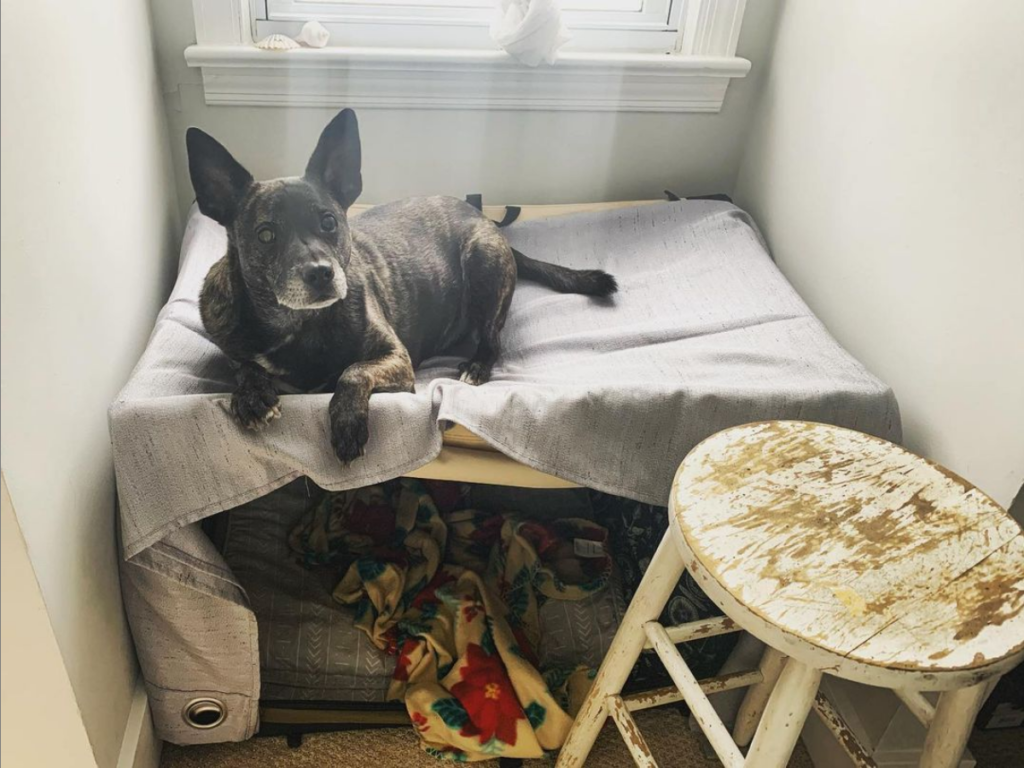
She realized Bugsy struggled with the toys she’d purchased for him, and she started to get creative about finding things for him to do by watching what he did naturally. She realized he was a plucker and started tying t-shirts up for a creative meal-time activity. “It gave me a chance to look at things from a different perspective and I realized I could do this myself, my way, and still find the results I was looking for without having to do it the way that I was taught,” Cassi shared.
He started to learn the behavior needed to play with the other toys, and rope and squeaky toys were added back into daily life. As she worked through those creative processes and figure out the angle of what she was trying to do, she decided to share her findings again through DIY Doggo’s Instagram and website.
We discussed some of what she’s learned in terms of methods and buzzwords as well, since there’s quite a bit out there in the dog training world.
Crossover
Cassi describes herself as what’s known in the industry as a crossover trainer, which is someone who has used what are called more traditional methods, typically corrections heavy, but has adjust their methods to primarily, or at least starting with, positive reinforcement techniques. “I did use a choke chain on my Shiba,” Cassi explained. “When I started with Bugsy, that’s what I knew, so that’s where I started. I was not always a certified dog trainer. I was just a dog owner with a very, very upset dog. Through that, I understand the impact I’ve had in my training over time, and knowing that impact, learning more about that impact, I’m choosing not to use those tools anymore.”
Here’s another consideration on crossing over with methods and some common things to think about, from Eileen and Dogs. (Note: I have not read the rest of Eileen’s website or blog yet, so I’m not sure of her other methods or advice, but I found this blog post helpful.)
Dominance
Most dog owners use the terms “alpha leader”, “dominance”, and “submission.” While dominance and submission can be understood to a degree through dog body language, it’s more helpful to think of dominance and submission as really wanting something or not wanting something instead of using these terms as dog owners in an attempt to show a dog “who is boss.”
Cassi shared why she’s quick to explain why the traditional understanding of dominance doesn’t have a place in training. “It just doesn’t exist in an everyday household,” she shared. “It’s not a sustainable way to look at navigating two different worlds, between human and a dog. If you’re not even in the same species pool, and if you’re not working to understand what that the other animal is trying to communicate, then why do we expect the animal to work to try to understand what we’re trying to communicate?”
She added, “If you’re looking to receive engagement from your dog, you need to also engage with them. And by that, I mean positively. You teach them the sociability you expect of them rather than dismissing it as too much. … What it comes down to is, it’s disproven in pet canines. There’s no pack in a pet canine. There’s no alpha. There’s just no alpha. There’s behavior. And there is a dynamic between behavior. For example, sometimes my 17-year-old dog gets one over on my 10 year old. Sometimes my ten year old gets one over on the 17 year old. And by ‘getting one over’, I mean they get to the cookie that fell to the floor first. Which one of them is dominant? The one who gets the cookie first? How do we define that? I don’t spend much time on it with owners, to be honest. I think it’s very important to them to find their own understanding in that, but I’m always willing to provide resources for those types of things.”
There’s often conflicting information out there, and Cassi knows it’s possible to find sources that support an idea. “You can always find information that supports your argument, but check the date,” she suggested. “Check the resource. See if there’s any updated information out there regarding the topic. Always remember, that these are pet dogs we are talking about in most cases. They’re pet dogs. We’re not talking wolves. We’re not talking feral dogs. We’re talking pet dogs in a house that are looking for socializing. That are looking for engagement. The more we remove that from their experience, especially as primary humans in their lives, the more undesirable behavior we actually end up with, believe it or not.”
And there’s a place to consider boundaries, but neither dog or human can benefit from one-sided conversation. “It’s really about dismantling that dominance theory,” Cassi added. “That idea that I need to be the sole proprietor of resource and information for this animal that I expect to live with me for the next ten to twenty years. I think that that is unrealistic in any relationship to expect that level of authority to work sustainably. So that I think is what’s really important to me and any of these conversations with any trainer, that’s really what you want to focus on, even in their handling of your dog. What type of relationship is the trainer willing to have with your dog? What type of relationship is the trainer willing to foster with you and your dog? The trainer is really taking their experience in working with other animals, other dogs, and seeing your case. Because that’s what it is, it’s a case. Saying, ‘Oh, this is why this is happening,’ and then giving the owner that information. Really, at the end of the day, it’s about helping the human understand that that’s not going to work for them and the dog is going to keep doing what the dog has been doing.”
Dr. Sophia Yin has an excellent breakdown on dominance on her website.
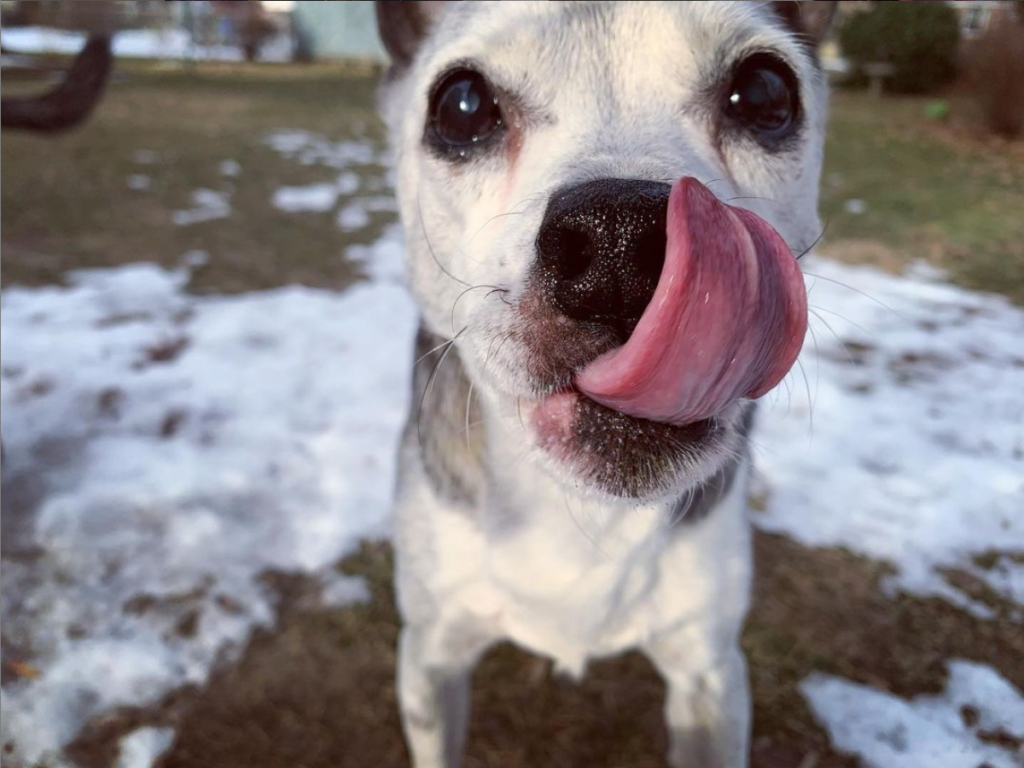
Repression
Repression, suppression, or compulsion training uses a tool (for example: choke, prong, or training collar) or physical or verbal force or intimidation to stop a dog’s behavior. This relies on the positive punishment quadrant of learning, where something unpleasant or unwanted is applied (or ADDED, hence the misnomer “positive”) until the dog stops. This can be used with positive reinforcement, which is when something the dog likes, like a treat, is applied (or ADDED) when the dog offers the desired behavior. There is a lot of ways to use this method, and different trainers use it in different ways. It is possible that the dog doesn’t learn how to make good choices with this method (and being able to make good choices in a stressful situation is crucial for reactive and aggressive dogs), or, at the worst, the dog suffers from learned helplessness, and does nothing, having learned they have no control at all over their circumstances. “They’re not living a fulfilled life at all,” Cassi said. “And I think that’s the biggest corner that the industry has turned recently, is understanding our dogs as things that live their own lives, instead of something in the corner that we feed twice a day and walk sometimes. That’s something I’m most excited about.”
Cassi added, “There are definitely folks out there who still believe in a control power relationship with an animal. And when one person is doing most of the instructing, one person is doing most of the communicating, one person is doing most of this, that, and the other, the other one does eventually just sort of fall back. And in a lot of the cases I’ve seen in older dogs who are coming in for training, and they’ve tried this, that, and the other, it’s hard for me, because we’ll get to, ‘Okay, what did you do when that dog was jumping previously? What was your strategy there?’ In some cases it was an e-collar, or it was a leash pop, or yelling at the dog, using a firm tone and saying, stop, worked. And it worked in that moment because punishment works, … and when I call that dog over to me to say hi to me and try to build my relationship with that dog as his trainer, the dog’s apprehensive. He doesn’t want to come over to me. When I started seeing that change, that positive change in my dog, he was willing to go see my roommates more and things like that, and also seeing that impact in a lot of my clients, I became very passionate about making sure that every time that your dog is awake, they’re having a good time. Or asleep, honestly.”
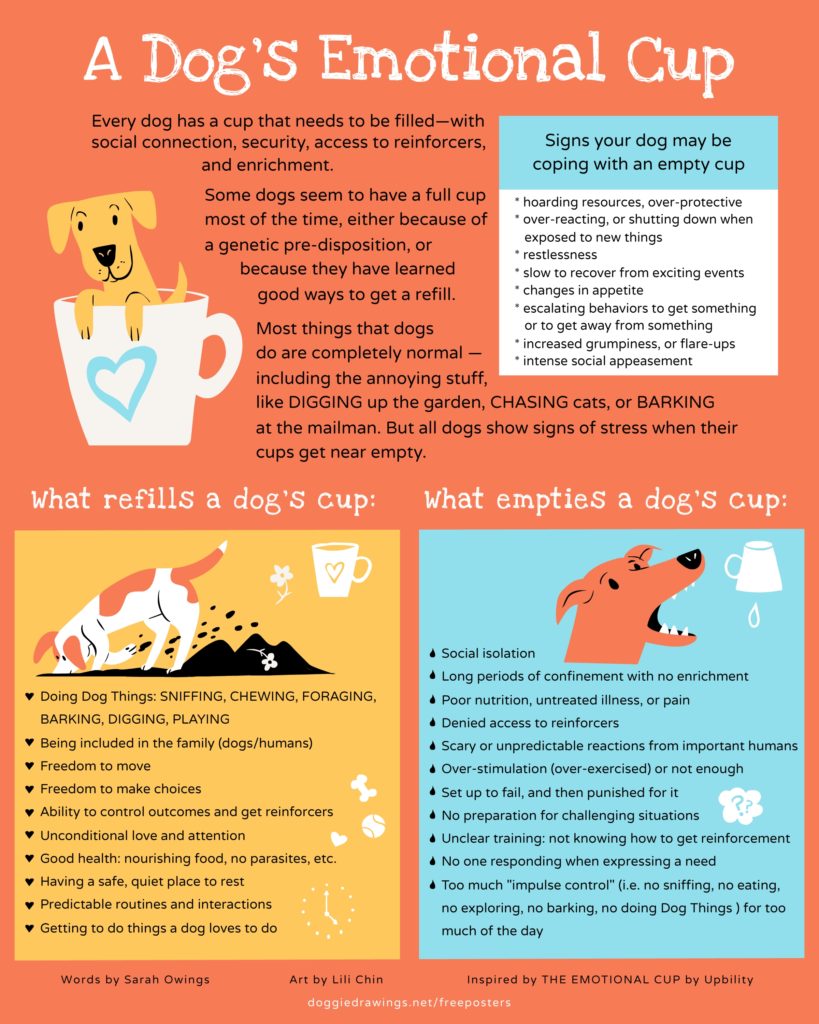
We’re also learning the effects on aversives on dogs. This study showed the increased stress in dogs who were trained with aversives. And this article from Preventive Vet has some additional information.
Force Free
Force-free is a growing movement to use management and modification in training.
“In my opinion, I think force-free in training is very achievable,” Cassi said. “But in everyday life, it’s something you work hard to aim for in terms of management and modification. What I mean by that is, I walk my dog on a leash in my neighborhood, and if he is in a harness, a back-clipping harness, which he often is, and he is walking along nicely and a squirrel runs up a tree behind us and he yanks me backwards, I might have accidentally used a little force there, just because I wasn’t expecting that to happen. I think it is important especially because there is this purely positive buzzphrase that’s going around right now. To clarify that, while I identify as a force-free trainer, what that means to me, is I work very hard to reduce and hopefully eliminate the amount of negative forceful experiences my dog has in everyday life. Knowing that he is a bit of a Tasmanian Devil dog sometimes and he puts himself in some sticky situations. If that ever happens, then the next day, the next week, we include that in our training and shift our priorities based on what happened through that less than awesome experience.”
She added, “Anyone can work towards being force-free and working towards that ideology. Force-free is a lovely ideology that includes removing force from your relationship and from your dog’s daily life as often as you’re able and making sure you’re coming at it from a LIMA approach.”
Remember, leashes are forces. Instinctive reactions, like jerking on a leash when startled, is a force. I work very hard as a trainer, when working with a reactive dog, to be mindful of the leash and what I’m doing when I’m startled by an off-leash dog or a person popping out of nowhere. Or even when I’m walking a dog who isn’t reactive but has a tendency to grab items he shouldn’t have. Moments of surprise or adrenaline need to be trained for and practiced. People use the term in different ways, but when the focus is on reducing negative experiences, as Cassi shares, then we can work on building those positive experiences and increasing desirable behaviors.
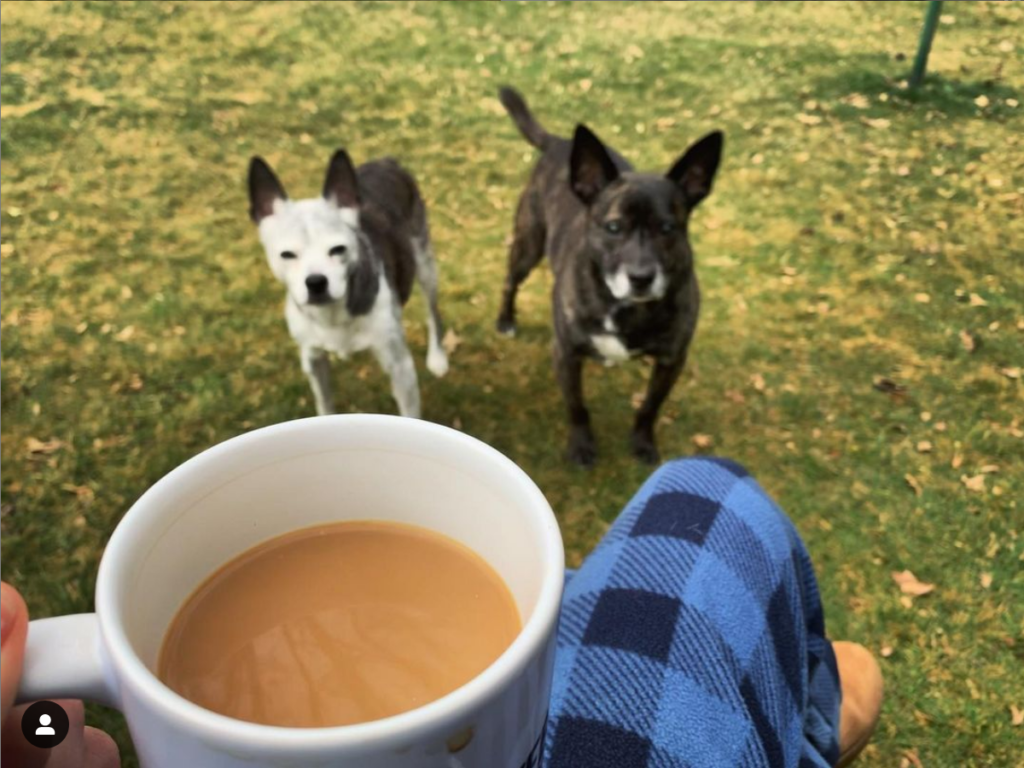
Fear Free
Fear-free means examining the dog’s emotional and behavioral state together in order to reduce stress.
“Fear free actually has an entire certification program,” Cassi explained. “It was originally and primarily geared towards veterinary offices and in a way in which that vets knowing veterinary experiences for animals are usually one of their most stressful experiences in life, how can we reduce the amount of stress in animal experiences in order to get a full read on their physical, mental, emotional, physiological health. … We’re looking at the dog’s emotional and behavioral state together. So we’re really looking at whether the dog is afraid, whether the dog is increased in stress response, if their stress is being reduced by certain effort. … Engage the dog in the environment in a way that’s soothing, thinking like going into a spa with aromatherapy. Imagine your dog going into a vet’s office like that.”
There are now training and shelter fear-free certifications as well. Cassi and I both have this on our list of things to add to our wheelhouse.
Did you know Dr. Marlow Ball of SoMa Animal Clinic is certified fear-free? One of the things I have to do when I’m setting up for class at her clinic is clear out all of the treats to another room because my pups in class get distracted with how good they smell if I leave them in the room.
LIMA & Quadrants of Learning
The four quadrants of learning come from operant conditioning, which helps a learner understand that there are rewards and punishments for behavior.
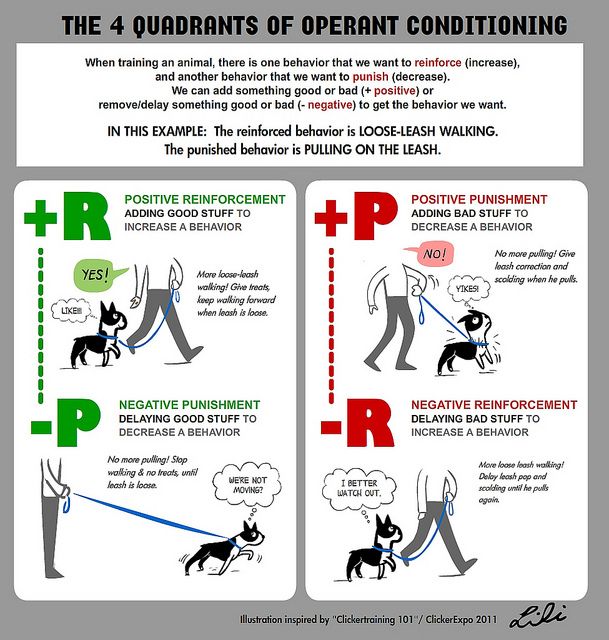
A lot of trainers describe themselves as positive reinforcement trainers, and it can be challenging to understand what that means. A lot of trainers use LIMA, which stands for Least Intrusive, Minimally Aversive. Both Cassi and I are certified through the Certification Council of Professional Dog Trainers, which holds to the Humane Hierarchy (below) and LIMA.
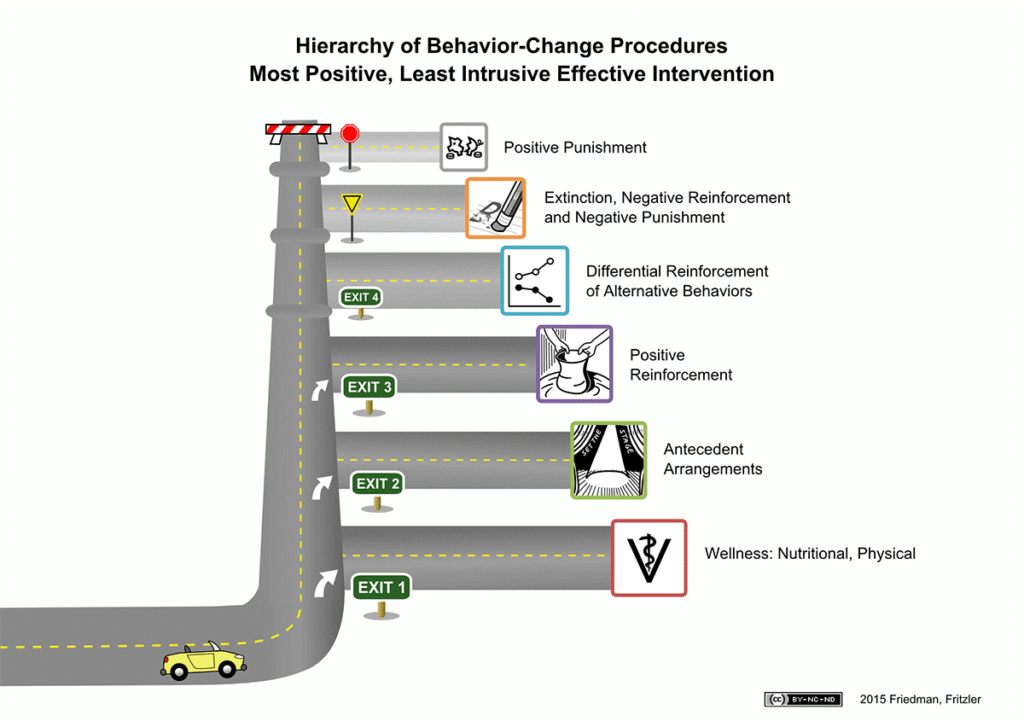
LIMA begins with health, environment, etc. before moving onto additional considerations. Positive reinforcement is the first quadrant of four: positive reinforcement, negative reinforcement, positive punishment, and negative punishment. Positive just means to add, and negative means to take away, so positive punishment doesn’t mean adding something good or reinforcing to the dog. Plus, operant conditioning doesn’t always offer possible side effects of the quadrants either, just what works.
But as we understand how dogs learn and utilize certain methods, we can also develop these skills into so much more. “Force-free positive reinforcement would mean things like removing the leash to practice stay work so that there’s no restraint involved,” Cassi shared. “Cooperative care is a lovely corner of this topic, where you’re teaching your dog to tell you it’s okay to start certain procedures, whether it’s grooming, vet visits or even just wiping their paws after coming in from a walk and things like that. Engaging with the animal in a way that’s conversational, which is a great word that you used earlier. And making sure that it’s something that you’re coming at from the canine’s perspective, the dog’s perspective. Whereas being a positive reinforcement trainer without that underlining consideration might mean that you are using treats but maybe also not considering the dog’s perspective in how or why they’re receiving the treats or how their behavior produces that reward.”
Positive Reinforcement
To understand why a trainer might select positive reinforcement as a primary training method, Cassi explained the four quadrants as listed and explained in the previous section. “I do think it’s important, as this whole conversation has been, to know all of it before you make that choice, because then if you do fall down the wrong trail, and you’re not sure how you got there, you can learn about how you got there and make your way back again,” Cassi said. “Positive reinforcement is when you’re adding something pleasant to increase behavior. So for example, if you want something to happen again, you want your dog to sit more than once ever in life, you tell them to sit once and then you add something awesome. Like we mentioned affection, praise, Bugsy really enjoys snacks, so I’d pop a snack in. If I get him up and on his feet again, he might sit again, and the reason he’s going to do that is because something positive was added to his experience after that behavior.”
As she learned more as a trainer, especially after bringing Bugsy home, she decided to focus on positive reinforcement. “The other three didn’t sound as interesting to me after I learned what I was doing with them,” Cassi said. “I was told that ‘if then’, and to me, that made enough sense at a very young age and with results in front of me, and again trusting the professional I was working with before I learned my own information. Then I learned ‘if then because’, and I learned a lot of the things I was told were working did work were also working against me in a lot of other ways.”
Using leash corrections and a choke chain actually had the reverse effect that she intended, she found. “I didn’t realize that in using leash corrections, I was making him more concerned with the stimuli in his environment instead of less concerned with the stimuli in his environment, which was my goal,” Cassi explained. “So instead of saying ‘Hey, scary things happen, then awesome quickly follows,’ I was saying, ‘That dog across the street barks at you, and then I’m going to make you sit, stay buddy.’ … That wasn’t cool of me and I didn’t know … I really found that the behavior most often increased if I was using positive reinforcement without alternative kind of symptomatic results on top of it. He found more interest in what was going on because I was offering him more valuable information [instead of] pain or suppression. … Which, punishment works. It works or it wouldn’t be there. It’s just not something that I’m choosing, because I too have the choice on how I want to engage with my animal. I don’t want to include punishment in my relationship with my dog. He already lives a life he didn’t ask to. He’s from the woods in Kentucky and now he lives on a quarter of an acre in New Jersey. I love him to pieces, and I want him every day to know that. … We want our dogs to be able to predict good things when we show up.”
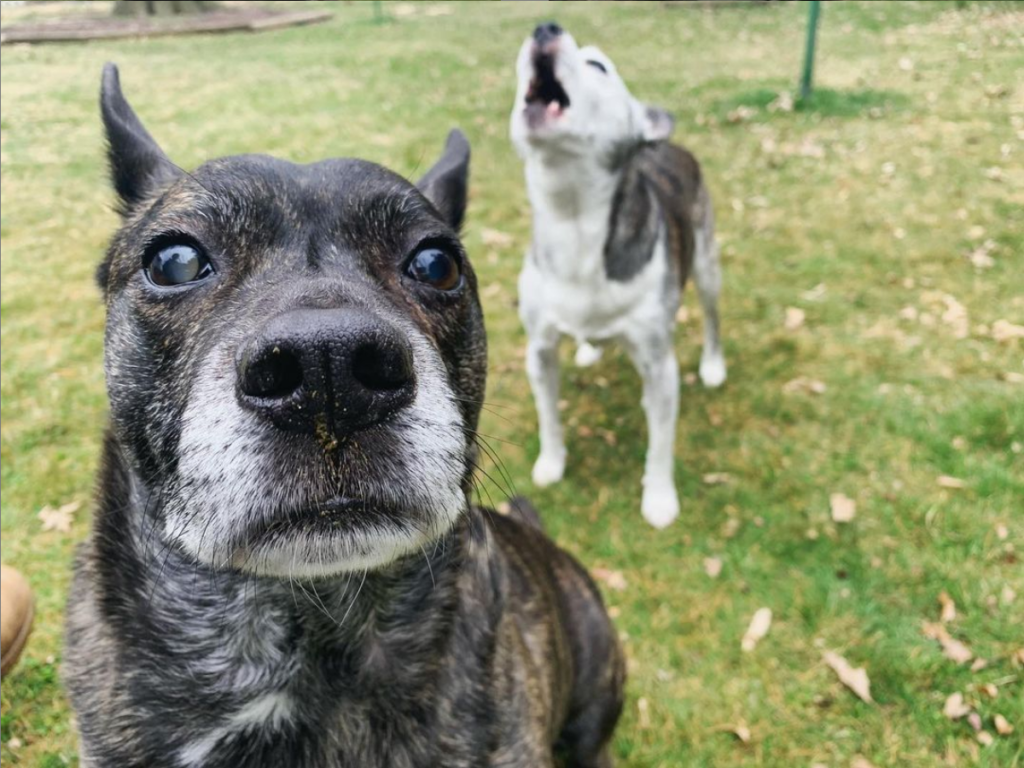
Balanced Training
While the idea of balanced training suggests achieving balance, the more practical application is that balanced training uses all four quadrants of learning. Cassi explained that there’s no precise or widely accepted definition, and she understands, from her experience, why dog owners would pursue balanced training or starting with a different quadrant instead of positive. She recommends looking at the bigger picture first and asking questions. What are the tools? The strategies? The gear? The ideologies?
“As a force free, positive reinforcement trainer, I really don’t think that there are many places for aversive tools in training plans,” Cassi said. “I think that it’s important to explore all options first before exploring that aversive method and having that conversation before enacting a training plan with your balanced trainer and setting those boundaries on both sides of the relationship. Working with a balanced trainer does not mean that every balanced trainer is going to start with a shock collar. It means that they might be willing to introduce that to the training plan down the line OR start with a shock collar. So really opening up that conversation and asking questions about, what are your philosophies around certain behavior modifications, and if you don’t have that verbiage in your relationship with your dog yet, even if you’re just asking the question, what will you do if my dog doesn’t sit, I think is a great place to start that conversation and understand where they’re going to start that conversation with your dog once that leash is in their hand. So again, it’s really up to you, and I think the most important part in exploring what type of trainer you’re going to be working with is making sure you understand their training plan, their philosophy, but also what that philosophy means in regards to your relationship with your dog. Because you live with them 24 hours a day, and you’re going to be seeing that trainer maybe a couple of hours a week. You want to make sure it melds well with your philosophy and your everyday experiences and expectations.”
She also recommends, “Check for certifications; learn the definitions of terms and buzzwords, and learn the science behind the types of training you’re exploring. Be comfortable with the information and ask questions to be sure you and your new trainer are on the same page before starting a relationship and remember that while some methods work in front of you, the bigger picture is most important. How will this training work for you and your dog in everyday life? Will it have any other impacts? For example, if I use an e-collar for jumping on people, will my dog learn to not like people? … Buzzwords imply ideologies (balanced, force free) but certifications indicate clearly the type of training and/or testing someone has completed to gain the certification (CPDT, fear free). That said, non-certified trainers can sometimes be better fit for folks than certified trainers based on their ideology, certification, and experience. Always do your research and ask questions and remember: you are your dog’s advocate.”
What are some of the methods we missed? Do you identify with a particular method? Why or why not? Remember, this is meant to be a discussion. For clients in Little Rock, I’m always willing to talk methods and why I train the way that I do. We can always change training methods used for a dog, and even change a cue completely if needed. There are certain methods that are prevalent in the south, but they are not the only methods. Here’s CCPDT’s LIMA Policy. Here’s the IAABC’s Position Statements. Here’s the Fear Free Certification Program. Here’s Dr. Sophia Yin’s stance on dominance. Be sure to follow Cassi on Instagram with DIY Doggo, Philly Unleashed, and SJ Unleashed. You can find her website here, and more from Philly Unleashed at their website and Facebook as well.
